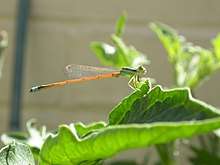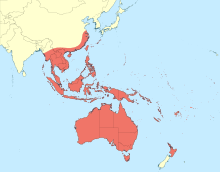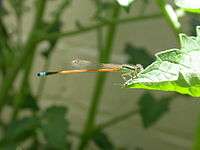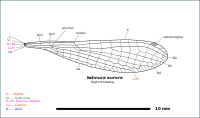Ischnura aurora
Ischnura aurora,[3][1] golden dartlet, also known as the aurora bluetail,[4] is a species of damselfly in the family Coenagrionidae.[1][5]
| Golden dartlet | |
|---|---|
 | |
| male | |
| Scientific classification | |
| Kingdom: | Animalia |
| Phylum: | Arthropoda |
| Class: | Insecta |
| Order: | Odonata |
| Suborder: | Zygoptera |
| Family: | Coenagrionidae |
| Genus: | Ischnura |
| Species: | I. aurora |
| Binomial name | |
| Ischnura aurora | |
 | |
| Synonyms | |
| |
Adults
A small apple green damselfly with black thoracic stripes and blue tipped yellow tail.[1]
Male
Eyes: Black half moon like cap above, olive green to dark olive below, which fade to pale olive beneath. Two azure blue spots are present behind the eyes. Thorax: Shining black with two pale grass green stripes. Sides are light green and white below. Legs: Pale greenish white with vertical stripe on femur, just above femur - tibia joint. Wings: Transparent. Wing spot: The wing spots are different in fore and hindwings. It is rose-red in forewings and uniform pale grey in hindwings. Abdomen: Bright reddish yellow. The second and seventh segments has upper narrow and broad black marks respectively.[1] Only 1/3 of length of segment 8 and full length of segment 9 tergite are blue. The base color of the segment 8 tergite is melanic black.[6]
Female
Eyes: Brown half moon like cap above, green to pale green below. Thorax: Shining black with two orange stripes. Sides are pale green. Legs: Pale white with vertical black stripes on femur, just above femur - tibia joint. Abdomen: A broad black stripe runs along the upper side of abdomen. Segments 8 - 10 do not have azure blue markings.[1]
Habitat
Found among vegetation along the banks of ponds, rivers, canals, marshes and wet rice fields.[1]
Distribution
Distributed from Australia, Pacific Islands, East Asia and Southeast Asia.[1] There are strong differences in DNA between the Asian forms of the species and specimens from the Pacific.[1] The form found in Indian subcontinent and Iran is Ischnura aurora rubilio Selys, 1876 and is now considered as a different taxon, Ischnura rubilio.[7]
Gallery
 Male in Australia
Male in Australia Illustration of Ischnura aurora wing
Illustration of Ischnura aurora wing.jpg) Photo of female wings
Photo of female wings.jpg) Photo of male wings
Photo of male wings
See also
References
- Dow, R.A. (2013). "Ischnura aurora". IUCN Red List of Threatened Species. 2013: e.T167375A1177456. doi:10.2305/IUCN.UK.2013-1.RLTS.T167375A1177456.en.
- Brauer, F. (1865). "Dritter Bericht über die auf der Weltfahrt der kais. Fregatte Novara gesammelten Libellulinen". Verhandlungen der Zoologisch-Botanischen Gesellschaft in Wien (in German). 15: 501–512 [510] – via Biodiversity Heritage Library.
- "World Odonata List". Slater Museum of Natural History. Retrieved 2017-03-03.
- Theischinger, Gunther; Hawking, John (2006). The Complete Field Guide to Dragonflies of Australia. Collingwood Vic.: CSIRO. p. 96. ISBN 978-0643090736.
- "Species Ischnura aurora (Brauer, 1865)". Australian Faunal Directory. Australian Biological Resources Study. 2012. Retrieved 8 April 2017.
- Rj, Rowe (2010-08-13). "Ischnura aurora (Brauer 1865) (Zygoptera: Coenagrionidae), an Australo-Pacific species". New Zealand Journal of Zoology. 37, 2010 - Issue 2 (2): 189–192. doi:10.1080/03014223.2010.488789.
- DUMONT, H.J. (December 2013). "PHYLOGENY OF THE GENUS ISCHNURA, WITH EMPHASIS ON THE OLD WORLD TAXA (ZYGOPTERA: COENAGRIONIDAE)" (PDF). Odonatologica. 42 (4): 301–308.
External links
![]()
![]()
